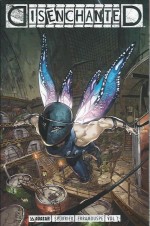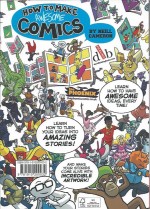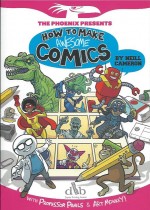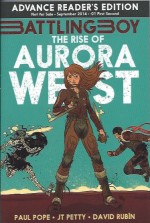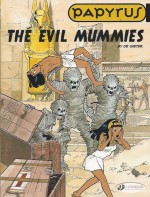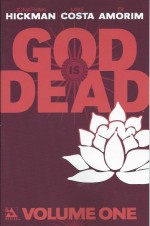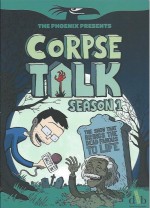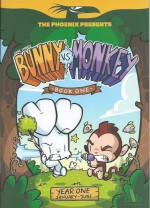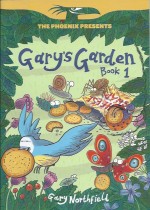
By Gary Northfield (David Fickling Books)
ISBN: 978-1-910200-09-4
In January 2012 Oxford-based family publisher David Fickling Books launched a traditional-seeming weekly comic aimed at girls and boys which sought to revive the good old days of picture-story entertainment Intent whilst embracing the full force of modernity in style and Content.
Every issue offers humour, adventure, quizzes, puzzles and educational material in a joyous parade of cartoon fun and fantasy and, in the years since its premiere, The Phoenix has gone from strength to strength, winning praise from the Great and the Good, child literacy experts and the only people who really count – the astoundingly engaged kids and parents who read it…
The Phoenix was recently voted No.2 in Time Magazine‘s global list of Top Comics and Graphic Novels and is the only UK strip publication started in the last forty years to have passed the 100 issue mark. The magazine celebrated its first anniversary by releasing a digital edition available globally as an app and is still continually expanding its horizons.
It is, most importantly, big and bold and tremendous fun. You should subscribe today…
Moreover, whilst comics companies all seem to have given up the ghost (in this country at least), old-school prose publishers and the newborn graphic novel industry have evolved to fill their vacated niche.
With a less volatile business model and far more sustainable long-term goals, book sellers have prospered from periodical publishers’ surrender. There have never been so many and varied cartoon and comics chronicles, compilations and tomes for readers to enjoy.
This year – at long last – many of the favourite serials and series from The Phoenix joined that growing market, having been superbly repackaged as graphic albums.
Two of them – Von Doogan and the Curse of the Golden Monkey and Bunny vs. Monkey – were selected for The Reading Agency’s prestigious Summer Reading Challenge (which began on July 12th): the first comic-books ever to have featured on the organisation’s Summer Reading Challenge List.
One of the most rewarding and captivating strips in the comic is marvellous minibeast comedy-adventure Gary’s Garden, crafted by Gary Northfield (Beano‘s Derek the Sheep, The Terrible Tales of the Teeytinysaurs).
It is the fourth fabulous release to assuredly delight and enchant young an old alike…
The premise is beguilingly simple and utterly addictive: laggard grown-up Gary, like most of us, doesn’t do as much as he should in his back yard – and the assorted birds, beasts and bugs despise him for it – but at least it means they can all live their lives in relative peace and quiet…
The occasional series began in #2, and this initial collection opens with ‘Chompy’, a rather irascible, over- imaginative but under-achieving caterpillar who here has to set straight a worm with delusions of grandeur…
‘Practice Makes Perfect!’ then peeps in on an artistically pompous spider who makes his enwrapped prey all play in his make-shift orchestra whilst an old worm whinges about the ‘Noisy Neighbours’ in the apples adjacent to his, after which ‘Spring Clean!’ sees the obnoxious garden birds wreak playful havoc with Gary’s socks and smalls as they dry on the washing line…
‘Larry Ladybird, Lord of the Jungle!’ reveals the inner dreamer of an action hero inside a little spotty bug, whilst manic squirrel Rupert kicks into overdrive in ‘Acorn Antics’ when his prospective winter larder is endangered by strong winds and vegetarian mole Thelma. Absolutely no semblance of sanity then returns as the ever-vigilant birds raid Gary’s larder for junk food after suffering a ‘Snack Attack!’…
In the pond, slow and sure Jennifer watches with poignant regret as all the tads grow their ‘First Legs’ and rush off pell-mell to join the metaphorical rat-race whilst in ‘Hide and Peek’ readers get a brilliant lesson in camouflage from a leaf bug, a butterfly and a stick…
Clearly a devotee of the works of Edgar Rice Burroughs, Mr. Northfield then wryly spoofs the Barsoomian Chronicles, when, in a moment of inspired madness we are introduced to ‘John Ladybird, of Mars’ as the self-appointed explorer crosses dimensions, vast gulfs and a garden trampoline for the journey of a lifetime.
Sadly, Chompy is not the most appreciative of audiences for such tales of wonder…
Birds are not the kindest of characters, but they’re not as dangerous as next door’s cat. Happily ‘Podgy Pigeon’ is smart enough to make fools of them all before heroic night stalkers ‘Boris & Monroe’ enter the picture.
The fox is a veteran ninja of darkness and only occasionally wonders if he was wise to take on excitable hedgehog Monroe as his apprentice…
‘Dream On, Chompy!’ finds our voracious idiot trying to rush nature in his eagerness to join his winged brothers in the sky, whilst an elderly spider tries – and generally fails – to remind everyone to take things easily in ‘“Mornin’ Henry!‒ after which frustrated country music star ‘Terrance the Snail’ makes his noisy debut and Jennifer in the pond makes a disturbing self-discovery in ‘Last Legs’…
‘Ronald the Spider’ reveals his tap dancing gifts to a literally captive audience before it’s Flash Gordon‘s a turn for a bit of leg pulling – all six of them – in ‘Zarpovia! Pt 1’ when Professor Ladybird Zarpov discovers an incredible alien world teeming with incomprehensibly strange life in Gary’s front room…
Recruiting bold adventurers Larry Ladybird, Lord of the Jungle and John Ladybird of Mars, the trio explore the glass-sided universe in the astounding ‘Zarpovia! Pt 2’, before those masters of darkness return in ‘Boris & Monroe: Bagsie Me First’, to prove that foolhardy bravery and astonishing agility are no substitute for a little caution…
There’s acrimony and dissent at a ‘Camouflage Club’ meeting, leading to a breakaway movement, but in the interim Gary gets a barracking from the birds in ‘Nice Hat’ and wily Humphrey Housefly lives another day after two ‘Grumpy Spiders’ can’t decide on who should eat him.
The splinter group ‘Mimicry Club’ barely survives its first meeting when mickey-taking poseurs gatecrash the event, after which sensitive Ladybird Melissa develops an abiding but unhealthy affection for the coldly distant, stoic ‘Mr Leaf’ to bring a close to our beastly cabaret.
But don’t fret because there’s one last treat in store. ‘Gary’s Garden: Top Chumps’ provides 34 fascinating pictorial Score Cards (also available as free printable download pages), revealing all the silly secrets and dreams of the quirkily quotidian cast.
The Phoenix Presents… Gary’s Garden is a truly laugh-out-loud comic treat: madcap, endearing and absurdly hilarious. Don’t miss out on the perfect opportunity to get back to – or get back at – Nature by…
Text and illustrations © Gary Northfield 2014. All rights reserved.
The Reading Agency is a charity whose mission is to give everyone an equal chance in life by helping people become confident and enthusiastic readers. The Summer Reading Challenge encourages children aged 4 to 11 to read 6 books during the summer holiday.
Children can read whatever they like just as long as they are borrowed from the library. Every time children finish a book they get stickers and rewards and there’s a certificate for everyone who finishes. The Summer Reading Challenge is open to all school children and is designed for all reading abilities.
Visit www.readingagency.org.uk
To find out more about The Phoenix or subscribe, visit www.thephoenixcomic.co.uk.

